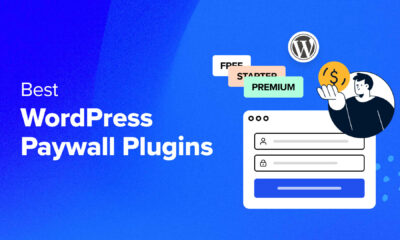Who doesn’t love saving time?
WORDPRESS
9 Best Etsy Alternatives for Sellers (More Freedom + Less Fees)
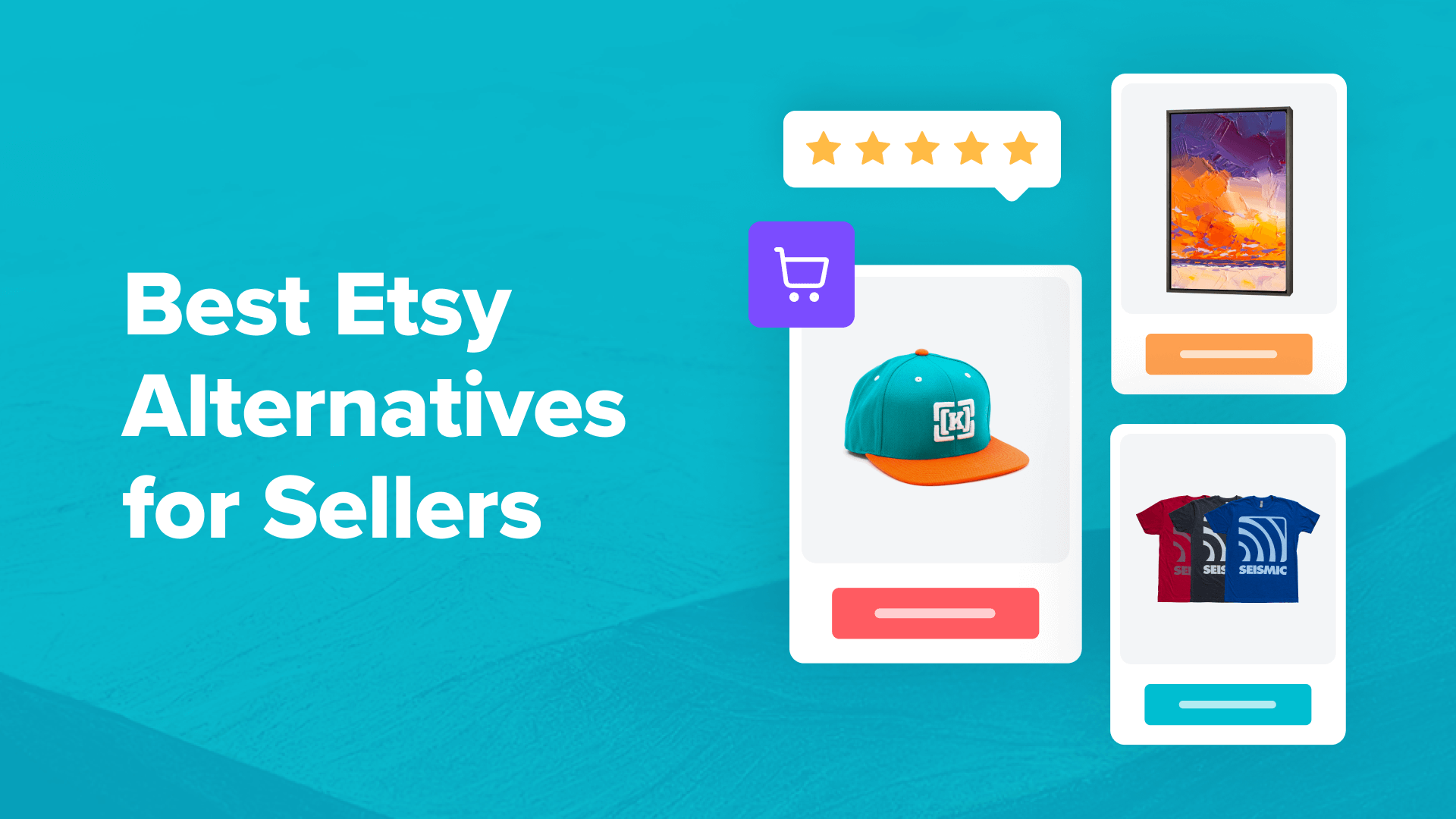
Looking for the best Etsy alternatives to sell your products?
Etsy is arguably the most popular e-commerce platform to sell handmade goods. But with the rise of seller transaction fees and the influx of dropshippers and print-on-demand merchants hopping on board, competition has become stiffer than ever.
In this article, we’ll give you the best Etsy alternatives for sellers so you can tap into a less competitive space and enjoy lower fees.
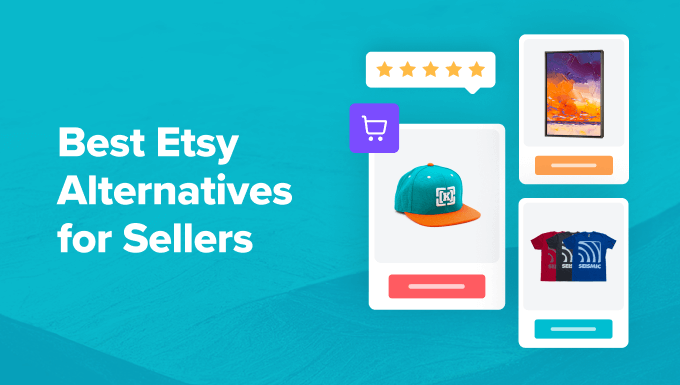
Why Look For an Etsy Alternative?
Since 2005, Etsy has become a popular platform for crafters and collectors to sell their custom-made, handmade, or vintage items. You can sell everything from home goods, collectibles, furniture, clothing, holiday items, crafts, and more.
That said, sellers have started to notice an influx of mass-market products that aren’t handmade. But that’s only the start.
In 2022, Etsy has raised its seller transaction fees from 5% to 6.5%, causing more displeasure among sellers, as it only eats into the razor-thin profit margins. So much so that Etsy sellers actually went on strike because of it.
Beyond the hyper-competitive space and the rise in seller transaction fees, you might also want to control your own customer data. Relying on a third-party marketplace means you don’t fully control your business.
Etsy can only take your eCommerce store so far. You have limited customization options and restrictive store design. That said, other platforms allow you to customize your store theme, colors, call to action buttons and even add your own upsells and cross-sells.
Best of all, you own your customer data, so you can send them emails to you keep them in the loop about new products, product categories, store discounts, or other news.
1. WooCommerce
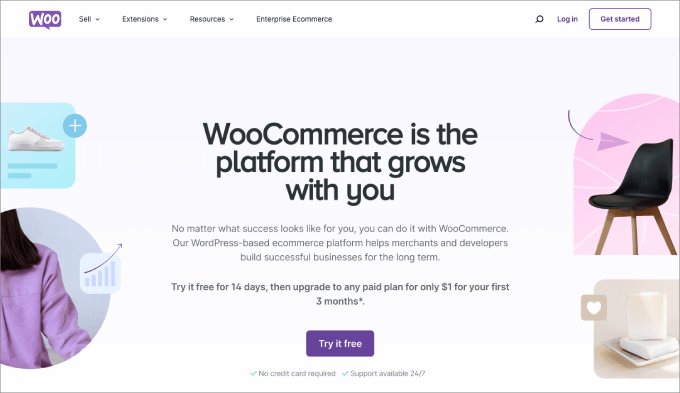

WooCommerce is the best alternative for creators who are ready to leave Etsy and grow their businesses. Since WooCommerce is the best all-in-one commerce platform, migrating your shop from Etsy to WooCommerce is seamless.
With Etsy, you’re limited to making yourself stand out from competitors. If your store looks like everyone else’s, buyers will treat your items as a commodity. Unlike most seller marketplaces, WooCommerce offers a full suite of resources and tools to help make your online store more in line with your brand.
You’re able to choose which payment gateways to accept, create pop-up campaigns to get visitors to stay, optimize SEO for increased traffic, add one-click upsells, and much more.
Here’s an example of what a website built entirely from WooCoomerce. Notice how clean the design is and the buttons are strategically placed to make adding to cart easy.


Plus, WooCommerce keeps everything in one place. For example, if you’re a retail store, you probably already have a WordPress website (or at least you should). In that case, rather than juggling between different platforms to manage your business, you’re able to house everything right from your WordPress dashboard.
You can start a WordPress blog, edit your website content, and manage your orders from customers without switching windows. It’s less confusing, and you’ll have to pay for fewer subscriptions.
You may also want to check out our list of the best WooCommerce plugins for your store.
Pros:
- WooCommerce is built right inside WordPress to keep everything in one place.
- Lots of customization options to boost sales and create your own brand
- Relatively easy to use
Cons:
Why We Recommend Using WooCommerce: If you want to create an Etsy-like store with WordPress, WooCommerce is the way to go. When you choose WooCommerce, you get all the profits. That means Etsy isn’t going to take a cut and eat into your margins. There are all kinds of plugins in the Woo Marketplace, so you’re pretty much able to add any type of feature you’d like to your store.
2. Easy Digital Downloads
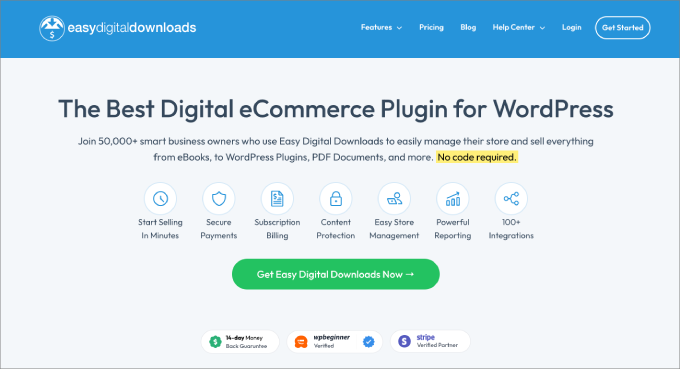

Easy Digital Downloads (EDD) is the best Etsy alternative if you sell digital products like digital art, planners, Canva templates and other downloadable items.
Like WooCommerce, Easy Digital Download is a plugin that lives directly in the WordPress dashboard, so you wouldn’t need to bounce between multiple platforms. Everything is one place, which makes everything convenient.
Etsy has become popular for selling digital downloads. Graphic designers and other artists can easily sell their artwork without the incurring the costs of having to print, pack, and ship the items.
Easy Digital Downloads allows you to create and design your product pages. When customers make a purchase, they can automatically access their downloads directly from your site or through email.
For instance, here’s an example product page of a digital download products page using EDD.


The beauty of EDD is that you get to control the entire checkout experience. That means, you can allow users to create an account for faster checkouts, add flexible payment options like recurring payments or subscriptions, offer discount codes, and more.
Beyond that, EDD has a wide selection of extensions. For instance, you can connect the plugin to an email marketing service, so you can continually send them new offers from your store or send them reminders to reduce cart abandonment.
If you plan on using EDD, you may want to check out our ultimate guide on how to sell digital downloads on WordPress.
Pros:
- It’s a great plugin for selling custom digital downloads
- They provide lots of customization features so you control the entire buying experience
- They make it easy for customers to receive the downloadable file.
Cons:
- EDD is only good for digital download products, not physical goods.
Why We Recommend Using Easy Digital Downloads: We like EDD as the go-to product for selling downloadable items. With this plugin, users get immediate access to the product. Everything is in WordPress, so you don’t need to go to a separate e-commerce platform.
3. Shopify


Shopify is a popular e-commerce platform with over two million merchants selling in over 170 million countries. While Shopify isn’t our top choice, it’s still has a lot going for it.
The main benefit of Shopify is its plug-and-play type of user experience. Everything lives within the Shopify ecosystem. You can easily find hosting, domain names, payment gateway, website building, marketing tools, order tracking, and much more inside of the platform.
They also already have a built-in tool for adding discounts. You can create automatic triggers for discounts based on a certain product, link, or seasonal promotion without writing code. And you can set a percentage, fixed amount, or buy X, get Y type of discount as well.
If you’ve ever been on the Shopify app as a seller, you probably have heard the famous “cha-ching” noise. The seller dashboard comes with plenty of reporting and analytics. You can see your recent sales and compare them to a previous time period. Also, you can view other valuable metrics like your store’s average order value, compare how well your sales channels are performing, and monitor where your visitors are coming from.
Pros:
- Shopify is a very easy-to-use platform.
- It comes with its own eco-system of apps and built-in tools to manage your online store.
- The platform integrates with marketing platforms, email services and other third-party apps.
Cons:
- The total monthly price can be expensive. You also have to pay for tons of monthly subscriptions for apps, plugins, and fees.
Why We Recommend Using Shopify: It’s hard to go wrong with Shopify, since it’s such a trusted and well-known brand in the eCommerce industry. It’s an all-in-one platform that gives you all the marketing and selling tools you need to scale your online store to however big or small you’d like.
4. eBay


eBay is a great alternative to Etsy if you still want to sell your products on an eCommerce marketplace. While you don’t get to fully customize your storefront like with WooCommerce or Shopify, you do get to take advantage of their existing audience with over 134 million active buyers. The platform has a wide global reach, which only ranks second to Amazon.
The biggest selling point for eBay is its auction feature. If you’ve got one-of-a-kind items, sometimes you rather auction that item off. These are products that have a limited quantity, which further drives up demand. You can leverage the auctions to capture the highest bidder by using scarcity tactics like a countdown timer to draw our FOMO (fear of missing out).
With eBay, you also get protection for buyers and sellers, which helps prevent scams. They will help to mediate the situation between you and your buyer. The protection also can give buyers confidence to shop on eBay since they know they’re always backed by the protection policies.
Pros:
- The auction feature can increase sales.
- eBay has built-in SEO to help your listings get seen.
- The platform is great for hard-to-value products, similar to Etsy.
Cons:
- eBay has a clunky interface.
- They also come with a lot of fees, like Etsy.
Why We Recommend Using eBay: eBay is a great alternative to Etsy especially for collectible or rate items. In comparison, Etsy is better for handmade goods. That said, eBay’s auction feature and built-in SEO is helpful for getting more eyeballs to your product and boosting revenue.
5. Wix
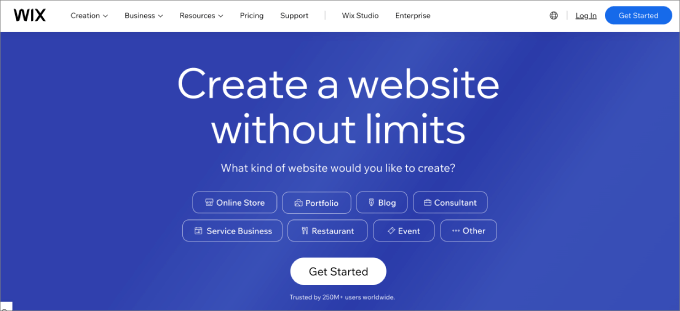

Wix is a website builder that primarily caters to beginners because of ease of use and drag-and-drop editor. It comes with over 900 beautifully designed templates spaning just about every business type imaginable from online stores, to bold portfolios.
The advantage of using Wix is that it’s built with performance in mind. One of the key factors for improving SEO is your website speed. Wix does a great job of insutring that all of their webpages load quickly due to their globally distributed CDN and data centers.
All Wix sites are optimized for core web vitals as well to maintain top-flight speeds. Plus, they include multi-cloud hosting services to avoid site crashes, so your customers never experince a disruption when trying to place an order.
Wix also easily connects to most online marketplaces including eBay, Amazon, Etsy, and others. Rather than sticking to one platform, you can leverage multichannel selling to reach new audiences and boost sales. Just create your Wix store and then seamless upload products directly from your site and track orders from the dashboard.
Pros:
- Wix is very easy to use.
- You can leverage multichannel selling due to marketplace integrations.
- Wix offers catalog and inventory management to track and fulfill orders.
Cons:
- Limited customizations compared to WooCommerce since it’s not built in WordPress.
Why We Recommend Using Wix: While Wix doesn’t compare to WordPress, it still is a good platform. Since it connects with online platforms, you can easily upload products from Wix to Etsy or Wix to eBay, making life a lot easier.
6. Amazon Handmade


Amazon Handmade is arguable the biggest direct competitor to Etsy and is a no-brainer when it comes to putting it on our list of alternatives. The beauty of Amazon Handmade is that you get to tap into the largest online retailer in the word boasting over 2.7 billion web visits per month. With such a massive potential reach, you would probably reach a larger global audience.
Amazon Handmade is an artisan-only section that is dedicated to selling crafted handmade products only. This is where you can sell personalized items rather than mass-producted products.
But the huge advantage is it’s lower seller fees. There’s no listing fees unlike Etsy, so you have the opportunity to profit more. In fact, 33% of Amazon Handmade sellers have profit margins above 20%.
Plus, you still get to leverage the FBA (Fulfillment by Amazon) model. This is where you send your products in bulk to Amazon’s warehouses. From there, they handle all the shipping, packing and labeling, so you don’t have to. With two-day free shipping for Prime members, you ensure a great customer experience right off the bat.
Pros:
- Amazon Handmade has lower seller fees.
- You get to tap into a bigger audience.
- You can leverage Amazon FBA, so you don’t have to worry about packing or shipping products on your own.
Cons:
- There are some customizations, but they are still limited when compared to WooCommerce or Shopify.
Why We Recommend Using Amazon Handmade: Amazon Handmade is the easiest switch you can make if you’re unhappy with the Etsy platform. It’s a direct competitor and offers pretty much everything you get from Etsy except lower fees and a better fulfillment process.
7. Big Cartel


Big Cartel is an eCommerce platform designed on servicing creative and artisitc sellers. Powering over 83,000 online stories, Big Cartel is an affordable option with customizable capabilities.
The best part of Big Cartel is the ease of navigation. You don’t need lots of experience building websites to get started. They come with a variety of free templates, so you never have to start from scratch. The themes also suit many niches like artists, creatives, bloggers, photographers, and more.
What makes Big Cartel unique is that they also offer live classes aimed to help you set up the basics. That way you’re not left in the dark trying to figure it out on your own. An insturctor takes you through every step through a session recording, so you know how to set up everything. This includes everything from adding products and creating discounts to packaging your products.
Pros:
- Big Cartel is specifically designed for creatives and artists, which might be great if you sell paintings or artwork.
- It comes with a built-in reporting dashboard and Google Analytics integration.
- They offer SSL security and other security controls to protect your site from hackers.
Cons:
- They are limited in the type of apps and integrations available.
Why We Recommend Using Big Cartel: Big Cartel certainly the big-name platform you might expect. But if you don’t have desire to become a large e-commerce brand then setting up a simple shop with easy-to-use features might be the way to go. Big Cartel gives you basic tools that get the job done.
8. Redbubble


RedBubble is a great Etsy alternative if you are mostly focused on print on demand products. Handmade items is where you make the items yourself or done with manual labor. On the flip side, print on demand items are usually designs printed on items like t-shirts, mugs, socks, hats, and other product categories. They’re more on the mass-produced side, but still appeal to niche audiences.
If you fall under the print on demand category, then Red Bubble is an excellent choice. They have a wide product category with over 70 product types like wall art, gifts, clothing and more. The audience size isn’t anything to scoff at either with over 40 million monthly site visitors.
Redbubble works by uploading your original designs to the platform. Then they’re listed for sale based on the product category you choose. If you’re not keen on brand promotion or running ads, you can simple optimize your listings on Redbubble and watch the sales come rolling in.
Also, like Amazon Handmade, Redbubble automatically prints, packs, and ships all orders to customers directly. That means you don’t have to worry about the fulfillment side of things.
Pros:
- Redbubble is perfect for print-on-demand sellers.
- You don’t have to handle inventory management.
- There’s a wide range of product catalogs to choose from.
Cons:
- it’s not great for handmade items since it’s strictly a print-on-demand marketplace.
Why We Recommend Using Redbubble: If you wanted to sell custom t-shirts, mugs, or anything where you print designs on products, then Redbubble is the place to go. Just upload your design, optimize your listing, and voila! There’s not a whole lot of work to it. That said, you also have less control because there’s little marketing you can do on your end.
9. BigCommerce


BigCommerce is a good alternative to Etsy because it’s a fully-hosted eCommerce website builder that is both suitable for beginners and advanced ussers. It packs a bunch of essential features fo a quick start and comes with high-performance functionality to scale your store up.
On the plus side, BigCommerce has a wide range of paid themes and it’s page builder makes it easy to design your store to your liking. It’s got plug-and-play widgets so you add social media profiles, testimonials, upsell buttons, countdown timers, etc.
One cool design feature is their swatches allowing users to hover over product images for instant zoomed-in views. This creates a better user experience, since you can instantly view products without landing on the product page.
Also, BigCommerce has comprehensive checkout features to help boost conversion rates. For example, you can create customer logins, add progress bars and even show all the available shipping methods. They even have a built-in abandoned cart recovery system, where you can send automatic emails to customers who exit your store without completing their purchases.
Pros:
- Lots of robust features to personalize your online store.
- There are lots of templates and design elements.
- BigCommerce integrates with online marketplaces and social media platforms for multichannel selling.
Cons:
- It comes with extra expenses since the best themes are paid and you’ll need to pay for addons as well.
Why We Recommend Using BigCommerce: BigCommerce is a useful alternative to Etsy. It’s similar to WooCommerce and Shopify in that you get full control over how your online store looks and you customize the entire buying experience. But it still doesn’t have as much apps and advanced SEO features as those two platforms have.
Frequently Asked Questions?
What’s the best alternative to Etsy?
There isn’t a one-size-fits-all answer, but we like WooCommerce for selling physical goods and Easy Digital Downloads for digital products.
How do you sell art without Etsy?
Easy Digital Downloads allows you to sell custom printable arts. When a customer places an order, they’ll land on an order page where they can directly download the product. You can also send a copy of the file via email.
What is the best site to sell handmade items?
WooCommerce makes it easy to sell handmade items because you can create product pages. You can customize the design of your online store to match your brand. Plus, you can always connect it to other software to add more functionality like OptinMonster for adding pop-ups, SeedProd for thank you pages and FunnelKit for one-click upsells.
We hoped this article helped you discover the best Etsy alternative, so you can start selling your handmade and custom goods. You can also check out our list of Shopify Alternatives or our actionable tips to increase sales.
If you liked this article, then please subscribe to our YouTube Channel for WordPress video tutorials. You can also find us on Twitter and Facebook.
WORDPRESS
29 Best Business Tools for Small Business (2024)

Over our years of helping small websites and companies grow and compete with the big guys, we’ve learned that the right business tools can make a huge difference in their success.
Whether you are looking for something to help you with email marketing, customer support, customer relationship management, or something else, there are plenty of plugins and software options that can fit the bill.
That’s why we’ve done the research and put together a huge list of the best business tools for small businesses. We’ve broken down everything into different categories so that you can find the best options for your needs.

Quick Pick: The Best Business Tools for Small Business
| Tool | Category | Price | Free Trial |
| Constant Contact | Email Marketing | $12 per month | Yes |
| Nextiva | Business Phone | $14.95 per month per user | Yes |
| Groove | Live Chat & Support | $16 per person per month | Yes |
| Gusto | HR & Payroll | $40 per month, plus $6 per month per additional user | No |
| HubSpot CRM | CRM | $90 per month per seat | Yes |
How We Test and Review Business Tools
Here’s how we reviewed different small business tools for this guide:
- Real-World Experience: At WPBeginner, we actively run small businesses of our own. We’re involved in starting new projects and managing existing websites, so we’ve used and tested these tools extensively ourselves. We ensure that they meet our high standards of reliability and ease of use.
- Comprehensive Research: We perform our own dedicated research to stay up-to-date on the latest developments in each category. We regularly update our recommendations accordingly, holding each tool to a high standard.
- User Feedback: We’ve combed through various third-party sites and even performed polls for users to see how they enjoy using these tools.
Why Trust WPBeginner?
At WPBeginner, we’re a passionate team with over 16 years of hands-on expertise in WordPress, design, and online marketing. Our mission is simple: deliver top-notch content and valuable resources to our audience. We achieve this by thoroughly evaluating and reviewing the plugins and software we actually use.
To learn more, see our complete editorial process.
Why Do You Need the Best Small Business Tools?
Running a business is no small feat. Luckily, there’s a wealth of online tools available to streamline your workflow and ease your burden. Choosing the right ones can feel overwhelming, though.
At WPBeginner, we’ve been testing and refining our top picks for years, keeping pace with the ever-evolving market. We’ve narrowed down our favorites to a curated list across various categories.
However, it can be a chore to figure out which is the right tool for your business.
Here are just a few reasons to add some of these small business tools to your repertoire.
- Increased Productivity: The right tools streamline business processes, automate repetitive tasks, and enhance overall efficiency. This leads to increased productivity among your team members, allowing them to focus on more strategic and value-added activities.
- Improved Collaboration: Many small business tools come with collaboration features that facilitate communication and teamwork. This is especially important in modern work environments where remote or dispersed teams are common. Collaboration tools enhance communication, file sharing, and task management.
- Enhanced Customer Experience: Tools such as a CRM (Customer Relationship Management) system help businesses manage customer interactions, track leads, and provide personalized services.
- Data-Driven Decision Making: Software with analytics and reporting capabilities provides valuable insights into business performance and customer journey. With accurate data at your fingertips, you can make informed decisions, identify trends, and adjust strategies to align with your business goals.
- Time and Cost Savings: Automation tools can significantly reduce the time spent on manual tasks, saving both time and money. You may have limited resources, so software that automates activities allows you to allocate resources more efficiently.
That said, it’s time to cover the best business tools for small businesses. Feel free to use the links below to jump to any section you need a solution for:
Email Marketing
Every business needs to build an email list. Sure, you could keep in touch with your customers via social media, but you don’t own the audience there.
An email list is something you own and can continually contact customers or leads anytime.
That’s why you need an email marketing service. These services allow you to send bulk automated emails to your subscribers. Not only that, you can segment users into groups, track their performance, and create marketing workflows.
1. Constant Contact
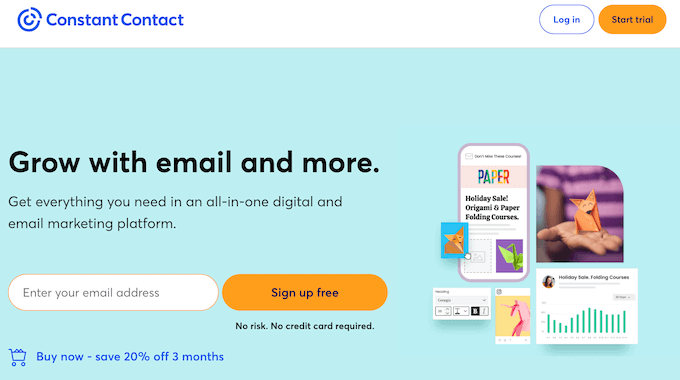

Constant Contact is the most beginner-friendly and fastest-growing email marketing service out there. It boasts an impressive 97% deliverability rate and offers a handful of time-saving automation that every small business could use.
Out of the many email service providers we’ve tried, we really like the user interface. From the moment you make your account, Constant Contact guides you through their simple process. You can create email newsletters, social media posts, landing pages, and events in minutes.
One of Constant Contact’s most unique aspects is its ability to segment the audience based on engagement level. Sure, it’s got all the standard segmentations, such as dividing contacts by location, membership, sales, email activity, and more.
That said, Constant Contact lets you segment your audience into four categories: most engaged, somewhat engaged, least engaged, and everyone else. For example, your most engaged customers could be your most loyal subscribers, to whom you can send upsell or cross-sell promotions.
Pricing: Plans start at $12 per month. If you need more storage, users, and advanced features, there are also higher-tiered plans.
Pros:
- Very affordable pricing
- It offers powerful integrations such as Facebook ads and eCommerce platforms.
- Constant Contact offers 200+ templates to fit your needs.
Cons:
- No advanced dynamic tags.
Why We Recommend Using Constant Contact: You can’t go wrong with Constant Contact as it’s good at just about everything. We especially like that they offer really outstanding customer support via live chat, email, phone calls, and community support, along with a large library of helpful resources. That way, you’ll always get your questions answered.
2. Brevo
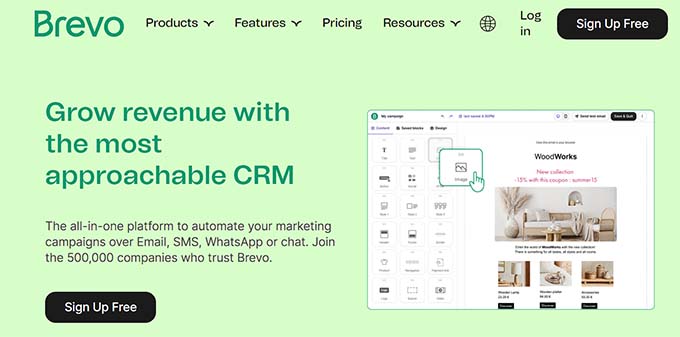

Brevo, formerly known as Sendinblue, is an email and SMS marketing software perfect for small businesses.
One of the best things about Brevo is that you receive unlimited email lists and contacts no matter which plan you choose. With contact segmentation, you can easily target smaller groups and engage them with relevant content.
Their advanced plans go well beyond just email marketing. They offer a sales CRM, live chat, landing page builder, and Facebook Ads integration. That means that for the price you are paying, you’re getting a lot more value than most email marketing services can offer.
Brevo is also known for high deliverability, guaranteeing up to 97%. That’s because they support many setup options, including email API, SMTP relay, webhook, and plugin. This means you can send bulk emails and have more control over your batch sends.
Pricing: Brevo is free to get started. However, their Starter plan begins at $25 per month and has unlimited contacts.
Pros:
- You will receive access to an unlimited number of contacts on any plan.
- A built-in CRM app is included.
- You can send advanced automation campaigns based on list-based behaviors.
Cons:
- You have to pay for a higher-tiered plan to get access to more advanced reporting features.
Why We Recommend Using Brevo: We like Brevo as an all-in-one marketing automation software that can do a little bit of everything. For instance, you can send timely SMS messages to promote your products and personalize them accordingly.
3. Drip
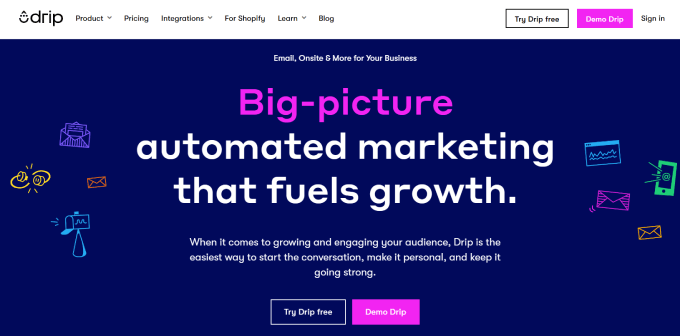

Drip is the best email marketing service for advanced users, especially for businesses looking to deliver hyper-personalized campaigns to their audience.
One of Drip’s standout features is its ability to create seamless workflow automation. The visual workflow builder makes it easy to visualize and customize user journeys.
When building your workflows, there are intuitive trigger options based on page visitors, tags, and other on-site behaviors that start the flow. Then, choose from dozens of actions to build the desired automation sequence.
If you’re running an online store, Drip offers integrations for WooCommerce, BigCommerce, and Shopify. That allows you to send strategically segmented campaigns to visitors and customers. For example, there are templates for just about everything, including cart abandonment emails and workflows.
Pricing: Pricing starts at $39 per month for up to 2,500 people on your email list. The price increases the more subscribers you have. All plans come with a 14-day free trial.
Pros:
- Drip has plenty of merge tags that dynamically replace content within an email based on the info you’ve collected in your contact or lead forms.
- You can A/B split test automation workflows to see which one performs better and ultimately provides the best conversion rates.
- It offers an eCommerce revenue attribution feature, so you know exactly how much revenue is generated from your email marketing campaigns.
Cons:
- Some learning curve is involved. For example, there are countless Liquid tags to learn about, which can be a lot of information if you’re used to using simpler email marketing services.
Why We Recommend Using Drip: At WPBeginner, we switched from MailChimp to Drip largely because of its more advanced segmentation and personalization features. That allows us to send more relevant and targeted campaigns to our readers.
For a more in-depth list of our favorite providers, check out our blog on the best email marketing services for small businesses.
Business Phone
While adding your mobile number to your WordPress site might seem convenient, it’s unprofessional and exposes your personal privacy.
That’s why you want to get a virtual business phone number and use a dedicated business phone service. This is a secure and professional solution. It allows you to:
- Make calls over the internet: Eliminate expensive phone bills.
- Use call forwarding, routing, and recording: Enhance team collaboration and capture valuable customer interactions.
- Track call metrics: Gain insights into wait times, hold times, and call duration to optimize your customer service strategy.
In essence, a business phone service is essential for any business that wants to improve customer service and effectively manage inbound and outbound calls.
4. Nextiva
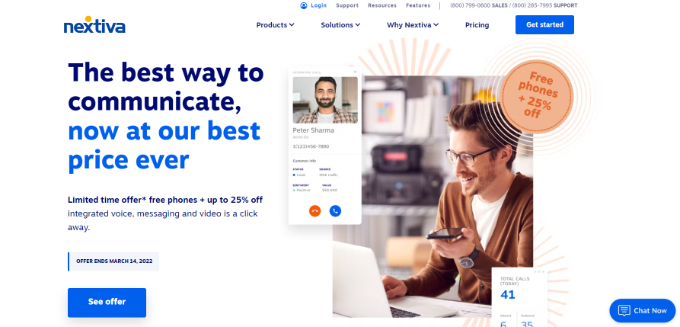

Nextiva is the best business phone service, and it makes it easy to manage communication between you and your customers.
The phone service is highly efficient and reliable, and you get helpful features beyond voice calling. There are plenty of features your call team can take advantage of, such as advanced call routing, voicemail to email and text, unlimited free domestic calling, text messages, and more.
Nextiva offers a treasure trove of data to help support your decision-making. You get critical information such as talk time, net promote score, first-time resolution rate, etc. Call center and sales team managers can easily interpret the data and come up with solutions to better improve performance.
If you’re using a traditional landline office phone system, Nextiva makes it easy to transition to a VoIP system. That means you can run your calls over the internet rather than complex landlines. They work with a variety of VoIP phones, headsets, and other call devices.
Pricing: Nextiva pricing starts at $14.95 per month per user for unlimited voice calling.
Pros:
- Nextiva provides 99.99% uptime for excellent reliability.
- They offer 24/7 customer support, so you always get the help you need.
- It’s an all-in-one phone system with a wide range of features to handle both outbound, inbound, and internal team communication.
Cons:
- Somewhat pricy, but the value is definitely there for what you pay for.
Why We Recommend Using Nextiva: Nextiva gives you everything you need to handle communication in your business. They offer a comprehensive set of VoIP service features that help you take your customer service to the next level. That way, your agents can work efficiently, and your customers can get their issues resolved quickly.
WPBeginner readers also get a special Nextiva Coupon to unlock an additional 21% off your purchase.
5. RingCentral


RingCentral is an affordable alternative to RingCentral that offers high-quality business phone services. Despite its cost-effective price, it doesn’t skimp out on quality.
With the entry plan, you get unlimited calls and texts, team messaging, file sharing, and other basic features you need. For smaller teams of 20 people or less, the $20 per user per month price point is a great deal.
We like the call routing capabilities, which allow you to direct callers to various departments and extensions. You can create and manage custom answering rules to ensure you get callers to the right people. You can even route the most important calls directly to your mobile device.
Pricing: Plans start at $20 per user per month, billed annually. Pricing varies depending on number of users and features available.
Pros:
- RingCentral comes with video meetings, team messaging, and screen sharing.
- It integrates with useful tools like Google Workspace and Microsoft, so you can easily connect data across platforms.
- You can enjoy a user-friendly interface that allows you to easily understand where and how to use all of its features.
Cons:
- You need to pay for the higher-priced tiers to get access to Interactive Voice Response (IVR) menu options.
Why We Recommend Using RingCentral: RingCentral is a good beginner-friendly option for small businesses just getting started with phone services. It lacks a few advanced capabilities that Nextiva has but gives you all the essential features needed for any business phone service.
6. Ooma


Ooma is one of the top VoIP providers for small businesses. It offers virtual numbers, collaboration tools, call forwarding, voice mail, and more. It’s great for small businesses without IT teams because it provides everything you need in an easy-to-use way.
Ooma features a virtual receptionist feature, which is great for directing calls for your small business. You can easily set up a custom greeting, provide a menu of options that guides callers to the right departments, and send them to various extensions. It also helps to reduce the call load and average wait times, which your customers will appreciate.
Every Ooma plan has a mobile app so that your agents can easily answer or make calls while on the go. You can do all the important tasks, such as checking your voicemail, reviewing stats, and more.
That said, when comparing Nextiva vs. RingCentral and Ooma, this service isn’t ideal for call centers since it doesn’t support desk and conference phones.
Pricing: Plans begin at $19.95 per month per user. No contract is necessary, so you won’t be tied to a year-long commitment.
Pros:
- Ooma offers unlimited domestic calling in the US, Puerto Rico, Mexico, and Canada.
- Pricing is relatively affordable.
- Easy to use mobile app.
Cons:
- Missing a few advanced features unless you upgrade to the higher plans.
Why We Recommend Using Ooma: We like Ooma because it’s ready to use out-of-the-box. It requires zero technical installation, and just about everything is already configured when installed. They use an auto-configuration technology that automatically detects all the settings needed for your system to work.
You may want to also check out our full list of the best business phone services for small businesses.
Live Chat & Support
Live chat software is a tool that helps connect customers to an actual human support representative so that you can resolve their issues in real time. That way, your customers can get the answers they’re looking for quickly.
They’ll spend less time sifting through your knowledge base and waiting to find a solution.
This goes hand-in-hand with your business phone services. By offering live chats on your website, you provide a more omnichannel customer experience, reducing your call load and average handling time.
7. Groove


Groove is a popular help desk software used by big brands like HubSpot, AppSumo, AT&T, and CloudApp.
It offers all the essential features a small business needs to deliver fast and responsive customer service. These include a knowledge base builder, shared inbox, collaboration and reporting tools, and live chat support.
Using Groove, we quickly realized how accessible the software feels. Think of it like a simple inbox that manages all customer communication in one place. Each conversation can be assigned to specific team members, so it’s clear who’s responsible for managing each conversion. Even better, you can label and assign agents to conversations based on certain conditions, such as department or type of inquiry.
Sticking to the theme of simplicity, Groove makes reporting as easy to understand as possible. Rather than giving you a ton of analytics that may confuse small businesses, they stick to the most important options.
For example, some of the metrics include response time, agent performance, busiest times, customer feedback, number of customers helped, and number of resolutions.
Pricing: Starts at $16 per user per month, billed annually. There is also a free trial available.
Pros:
- Groove integrations with the most popular business tools like Shopify, Slack, and Mailchimp.
- The knowledge base builder is customizable, and there are time-saving AI writing tools to help you quickly create support articles.
- Live chat lets you deliver fast service to customers
Cons:
- Groove isn’t the most customizable in terms of layouts and themes.
Why We Recommend Using Groove: Groove ranks as our top choice based on its value and ease of use. The entire system is easy to adopt, so you can better manage your support reps without having to spend a lot of time training them on how to use the software.
8. Heroic Inbox


Heroic Inbox is the best WordPress-powered help desk and customer support market in the market. It allows you to easily manage customer emails and support tickets right within your WordPress site.
This can streamline workflow by keeping all support-related tasks in one place so you can respond to customer inquiries faster.
After testing the inbox, we found that it comes with all the features you’ll need to manage support emails. For instance, you can create canned responses, add notes to conversations, track your ticket history, and assign messages to team members.
Best of all, it pulls multiple inboxes into one place. Chances are, you may have various inboxes to respond to, such as sales, support, customer service, and partnerships. This allows you to ensure that an important message is never missed.
If you want to add knowledge base capabilities, then you’ll simply need to download Heroic KB, which gives you the ability to add a searchable knowledge base to your website.
Pricing: Starts at $199.50 per year.
Pros:
- Manages customer service inquiries directly in WordPress.
- You can connect multiple inboxes in one place.
- It offers the ability to add notes and assign tickets to users.
Cons:
- It doesn’t have live chat capabilities.
Why We Recommend Using Heroic Inbox: Juggling a lot of software can be a problem for a lot of small businesses. With Heroic Inbox, you can manage all inquiries in your WordPress dashboard. Since it lives within the WordPress ecosystem, it also seamlessly connects with other plugins, such as WooCommerce.
9. LiveChat
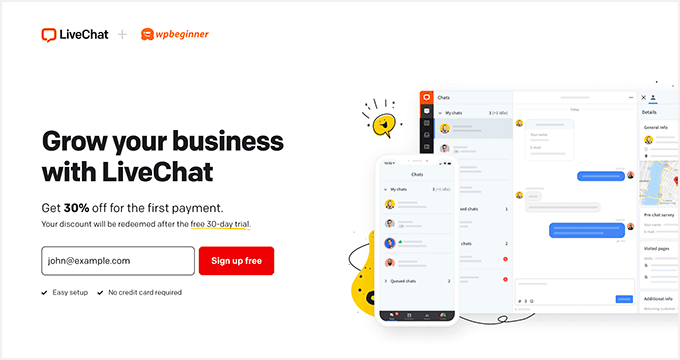

LiveChat is an all-in-one customer service software that works seamlessly for WordPress website owners. With over 35,000+ businesses that trust LiveChat, it’s a very popular tool for building live chatbots.
You can create a chatbot that asks the user questions before they’re automatically transferred to the right agent. During the chat, the agent is able to share files back and forth with the customer, send calendar links, or complete a purchase. On top of that, you can set up canned frequently asked questions type of responses to save time.
Beyond that, you can add pre-chat survey forms before and after each live chat session. That way, you’re able to evaluate your sales reps and customer support agents and how they’re performing.
It even integrates with popular tools like HubSpot, Zendesk, and Google Analytics, so you can better understand where your customers are coming from and who they are.
Pricing: LiveChat starts at $20 per person, billed annually, with higher-priced plans that track more users and better features. There’s also a free plugin available.
Pros:
- Plenty of integrations to seamlessly connect data across platforms.
- You can initiate a chat with a visitor as they are browsing on your site.
- There are lots of customization options to help users find a solution.
Cons:
- Price can quickly add up for large teams.
Why We Recommend Using LiveChat: LiveChat is an AI-powered help desk software that has a lot of advanced tools to help you sell more. For example, their custom forms, product cards, and AI automation can help turn inquiries into actual sales.
10. HubSpot Chat


HubSpot Chat is an all-in-one marketing platform that also offers a chatbot builder and live chat feature.
You’re able to customize the live chat design to help route leads and customers to the right person on your team. The live chat widget can be edited to match the look and feel of your brand. You can even send targeted welcome messages on your live chat widget based on segments of your audience or different web pages.
The routing feature works during a chat, where your services team passes a lead to a sales rep. In addition, it provides useful automation features so you can deliver canned responses for faster response times.
Since HubSpot is an all-in-one tool, all chats are automatically stored in the CRM. That means your team will have a clear view of each customer interaction.
Pricing: It’s free to get started. But if you want the suite of marketing tools or CRM, you’ll need to buy the entire package. Prices vary based on what suite you choose.
Pros:
- HubSpot Chat is free to use.
- You can connect the tool to Slack so your team gets immediate notifications when a visitor requests to speak with your support team.
- You’re able to route leads to anyone on your team.
Cons:
- It’s missing advanced features such as post-chat survey forms.
Why We Recommend Using HubSpot Chat: We like HubSpot Chat because it offers all the essential features of live chat software and is absolutely free to use. That said, if you want more advanced automation or more sales-related features like product recommendations, then you may want to consider LiveChat or ChatBot instead.
11. ChatBot
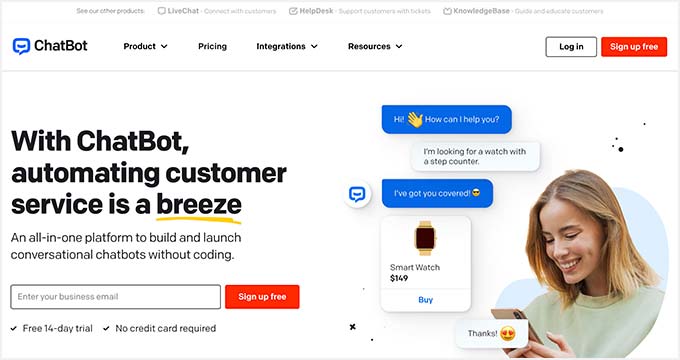

ChatBot is the best helpdesk software for creating AI-generated answers to customer questions.
Where ChatBot stands out is its ability to build visual workflows that help customers get their questions answered and guide them to a sale. It comes with pre-built templates so that you can use them out of the box. For example, after a customer asks a question about a specific product category, you can immediately offer a limited-time discount to incentivize visitors to take action.
If site visitors want to chat with a real person, you can easily forward them to a live customer support representative. That said, the customization options are quite limited compared to LiveChat.
But, when it comes to AI automation, ChatBot can make your life easier. For example, depending on how users interact with your site and chatbot, you can add them to a segmentation and then import them to a CRM or email marketing service. This is great for nurturing leads and sending follow-up emails.
Pricing: Chatbot starts at $52 per month, billed annually or $65 month-to-month. However, there is a 14-day free trial, with no credit card required.
Pros:
- ChatBot saves time with its powerful and expansive automation features.
- It allows you to segment lists and trigger actions based on visitor behavior.
- It integrates with WooCommerce and WordPress.
Cons:
- ChatBot lacks high-level live chat features.
Why We Recommend Using ChatBot: If you want to automate your helpdesk and chat support, ChatBot is the way to go. It has many templates that help guide users into a sale.
Also, check out our expert picks of the best WordPress chat plugins.
HR & Payroll
Managing your team members is arguably one of the most important functions of a business. No matter what type of business you run, you’ll need to pay your employees and manage their hours.
With HR payroll software, you can automatically send out paychecks through bank direct deposit, manage PTO and bonuses, streamline employee onboarding, withhold a percentage for taxes, and more.
When your HR and payroll are organized, employees know what to expect, and you don’t have to worry about running into tax compliance issues.
Best of all, HR software streamlines all the tedious admin tasks that you would otherwise have to do by yourself.
12. Gusto


Gusto is the best payroll and HR software that helps you automate both basic and advanced payroll tasks for employees and contractors. With its beginner-friendly approach to payroll management, it’s definitely a tool to have in your corner to ensure everything runs smoothly.
Even if you’re a small business without a full accounting team, Gusto makes it easy to handle payroll. It automatically runs payroll for you as many times a month as you need, and taxes are filed automatically. In addition, it automatically syncs health insurance, workers’ compensation, time tracking, 401K, PTO, and more.
Besides payroll, Gusto makes hiring and onboarding a breeze. There are features like custom offer letters, onboarding checklists, document signing, and even software account creation.
Pricing: Gusto starts at $40 per month, plus $6 per month per additional user you add.
Pros:
- Relatively affordable to use.
- Very beginner-friendly for both business owners and employees.
- Gusto is a self-service tool for employees where they can hop online to check their pay stubs and important documents and request time off without the need for HR to intervene.
Cons:
- Gusto is only available in the United States.
Why We Recommend Using Gusto: Gusto is an all-encompassing tool for payroll and HR tasks. You don’t have to worry about the nitty-gritty tasks like filing payroll and tracking all the taxes withheld. Plus, its higher plans offer next-day deposits, so employees get paid faster.
13. BambooHR


BambooHR is an excellent HR software and payroll solution for small businesses. The program is better suited for human resource tasks like compensation, hiring, onboarding, and company culture.
Inside, you get an application tracking system (ATS) that helps you speed up the hiring process and weed out potential applicants who don’t meet the job role requirements. Its automated alert features ensure you stay on schedule and keep candidates in the loop during the hiring process.
Once you’ve made your decision, you can use one of the many offer letter templates that come with auto-fill features so the new hire can sign and accept everything digitally.
That said, Bamboo HR also does all of the essential payroll tasks. It automates tax filing, so you don’t have to do it manually. As a result, you’ll avoid tax penalties and ensure you accurately report your employee earnings and taxes withheld.
Pricing: BambooHR offers free pricing quotes. To receive customized pricing, you will need to complete their contact form.
Pros:
- BambooHR offers self-service tools so employees can access information such as tax forms and pay stubs online.
- It automates the payroll process to avoid mistakes.
- The ATS makes hiring much easier and faster.
Cons:
- BambooHR is not as contractor-friendly as Gusto since it doesn’t have many features that cater to freelancers.
Why We Recommend Using BambooHR: BambooHR is a great choice if you have a remote team based internationally (outside of the U.S.). It makes it easy to manage your hiring and payroll across multiple countries.
14. QuickBooks
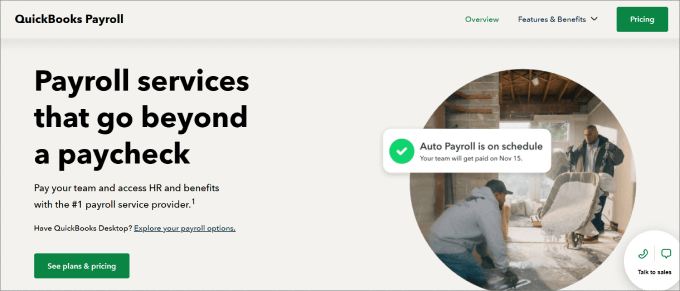

QuickBooks is a payroll software designed to make life easier for small business owners. It’s primarily used for accounting tasks, allowing you to calculate all your balance sheets and perform payroll.
One key area where QuickBooks shines is that it offers same-day or next-day direct deposit processing, depending on the plan you choose. You also get useful features such as automated tax calculations and payroll, business receipt capture, paycheck creation, and more.
There’s a dedicated mobile app, so employees can easily access their PTO and health information and even look into their paystubs on the go. For administrators, you can manage payroll from anywhere, ensuring your team never misses payday.
Pricing: Price starts at $37.50 per month, plus an additional $6 per additional employee per month.
Pros:
- Quickbooks offers a 30-day free trial.
- For Elite users, QuickBooks Payroll provides a tax penalty protection of up to $25,000 per year.
- QuickBooks Payroll integrates with QuickBooks Online, meaning you get a payroll and accounting system in one.
Cons:
- There are limited third-party integrations.
Why We Recommend Using QuickBooks: If you’re focused on getting your accounting and payroll right, then QuickBooks is the way to go. With the tax penalty protection, you’re getting great coverage. That means if you make an error, they’ll not only help you to fix the issue but also cover any penalty and interest fines along with it.
For a more comprehensive list, read our blog post on the best payroll software for small businesses.
CRM
Juggling customer data across scattered Excel sheets can be chaos. You may deal with missed follow-ups, forgotten birthdays, unsent emails, mixed signals, and frustrated teams and customers.
CRM apps eliminate this nightmare. They consolidate all customer data into a single, accessible platform. This empowers your sales, marketing, and customer support teams to:
- Effortlessly access information: No more scrambling for details.
- Personalize the customer journey: Deliver targeted experiences based on customer history.
- Boost efficiency: Automate tasks and free up time for strategic work.
Sales reps can prioritize high-value opportunities and close deals faster. Plus, marketers can leverage customer insights to craft impactful campaigns. Customer support gains a complete view of each interaction, providing exceptional service every time.
15. HubSpot CRM
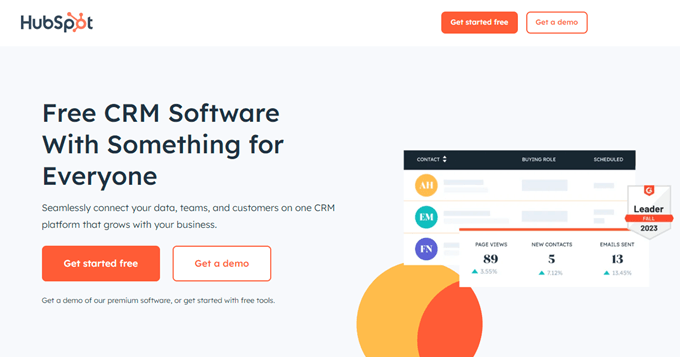

HubSpot CRM is the most popular CRM software on the market. It is cost-effective and offers a wide range of features, making it a great choice for most small businesses. You can get started with the free plan, which already gives you access to unlimited users and contacts.
Where HubSpot excels is its all-in-one capabilities. Since it combines sales, marketing, customer service, CMS, and operation hubs, you can easily connect data between departments. For example, you can easily pass contacts from your marketing team to the sales department without having to sync information to another system.
HubSpot is also really easy to navigate. It provides a full picture of customer interactions and comes with customizable reporting dashboards so that you can see how your team is performing. By looking at the opportunities and deal stages, you can quickly see what’s currently in the pipeline and focus on high-leverage prospects who are ready to buy.
Pricing: Hubspot CRM is free to get started. If you want the entire marketing suite, it’s $800 per month for 3 seats, billed annually, and an extra $45 per month per additional user. HubSpot Sales suite costs $90 per month per seat.
Pros:
- HubSpot has an easy-to-use interface.
- There are tons of features and even apps that you can download to make your experience better.
- Visual dashboards and reporting make it very easy to track team performance and spot opportunities for growth.
Cons:
- While HubSpot has a very generous free plan, its pricing gets steep quickly if you wish to upgrade.
Why We Recommend Using HubSpot: HubSpot is one of those can’t-miss tools for beginners. Sure, it could be more customizable or offer more affordable plans. But with that said, its free plan is enough to get small teams started.
16. FunnelKit Automations
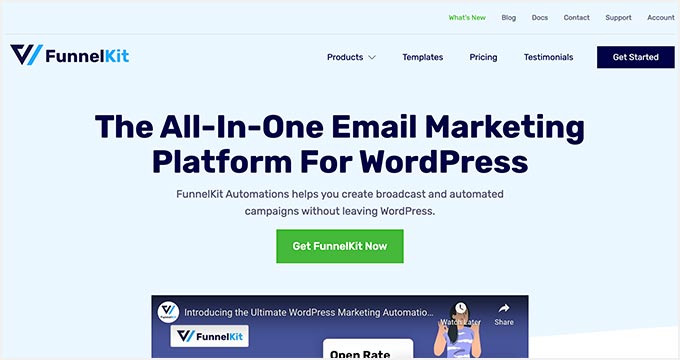

FunnelKit Automations is the best CRM and marketing automation engine for WooCommerce. It’s filled with a wide range of features to help get your online more repeat sales and higher order values.
Geared towards e-commerce business owners, you have a complete 360-degree contact view of your customers. You’ll be able to see their name, gender, email, tags, lists, geographical location, and custom field data.
In addition to the CRM tool, you can build high-converting checkout pages and flows. The drag-and-drop builder connects with other major page builders, such as Divi, Elementor, Oxygen, and Gutenberg.
Once customers complete the purchase, you can create upsell pages to showcase higher-tier products, increasing your total order value.
Pricing: FunnelKit starts at $99.50 per year. That said, there is a free version as well.
Pros:
- You get plenty of automation templates and workflows to increase conversions.
- You can view the customer’s complete profile, including purchase history, order placed, etc.
- Everything can be tracked, including what pages and workflows led to revenue.
Cons:
- You’ll need a mailer plugin, such as WP Mail SMTP, since WordPress isn’t built for high-volume email.
Why We Recommend Using FunnelKit Automation: If you’re running an online store, adding FunnelKit Automation is a no-brainer. Keep your opt-in leads and customers organized so that you can send them more relevant product recommendations.
17. Pipedrive


Pipedrive is a sales-focused CRM app for small businesses. It’s an all-in-one sales platform to boost revenue and track all of your leads and customers.
What we like about Pipedrive is its smart, in-platform tips. It comes with a sales assistant that provides performance tips and recommended features to help your team get acclimated to the software. For example, if you’re not sending follow-up emails after demo calls, it might send reminders to your reps.
Pipedrive goes beyond simple CRM with powerful automation features. Imagine automatically nurturing leads with timely emails, assigning tasks, and moving deals through your pipeline.
These automated workflows free up your sales reps to focus on closing high-value deals, not repetitive tasks.
Pricing: Pipedrive begins at $14 per seat per month, billed annually. But there’s a free 14-day trial you can get started with.
Pros:
- Fairly affordable to use.
- The smart assistant feature helps you improve your team performance.
- It has a lead enrichment feature, which scrapes data online to find information about your prospects based on the email you’ve collected.
Cons:
Why We Recommend Using Pipedrive: If you want a comprehensive sales tool to help manage your leads and drive home more revenue, Pipedrive is a solid choice. They offer many AI-powered features to make your life easier and save a lot of time.
If you want to learn about other options, check out our list of the best CRM apps for small businesses.
Bonus Small Business Tools
Aside from these top business tools that we mentioned above, we also use and recommend the following plugins to better manage our WordPress sites.
- WPForms is the most beginner-friendly contact form plugin used by over 6,000,000 sites. It features an intuitive drag-and-drop form builder, allowing you to build beautiful contact forms, payment forms, user registration forms, multi-page forms, and more.
- All in One SEO is a WordPress SEO plugin that helps you improve your WordPress SEO. It provides powerful on-page SEO optimization tools to help search engines better crawl and index your site, among many other capabilities.
- SeedProd is the ultimate drag-and-drop page builder plugin for WordPress. With this software, you can design high-converting and beautiful pages that convert visitors into leads and leads into customers. You can create everything from landing pages and custom home pages to 404 pages and more.
- MonsterInsights is the best Google Analytics plugin for WordPress. It brings the power of Google Analytics right to your WordPress dashboard, so you can get detailed reports of important metrics to see what’s working and what could be improved.
- OptinMonster is the best lead generation and popup plugin that helps you convert website visitors into subscribers and customers. With this tool, you can create a wide range of campaigns, including popups, scroll boxes, floating bars, and fullscreen welcome mats.
- MemberPress is a popular WordPress membership plugin for building membership websites. It has advanced membership features, including the ability to create gated content, add member levels, accept payments, create members-only forums, and more.
- PushEngage is a web push notification software that helps you engage and retain visitors once they’ve left your site. When users leave, you can send them all types of reminders, such as product announcements, blog post notifications, cart abandonment reminders, and more.
- RafflePress is a WordPress giveaway and contest plugin that lets you run all sorts of competitions. For example, you can run a giveaway to grow your email list.
- WP Mail SMTP is the best WordPress SMTP plugin for improving the deliverability and security of your emails.
- WP Simple Pay is the best Stripe payments plugin for WordPress. It allows you to easily create payment forms or buttons that accept 13+ payment methods and collect recurring payments.
- Smash Balloon is a social media feeds plugin for WordPress websites. It allows you to display custom Facebook, Instagram, Twitter, and YouTube feeds on your site to boost followers and engagement.
- WooCommerce is the world’s most popular eCommerce platform. It is cost-effective, super-flexible, and easy to use for beginners. You can easily create product pages, accept payments, manage orders, and much more. Basically, you can create your entire online store from scratch.
Frequently Asked Questions About Business Tools
What should you look for in a business tool?
The most important factors to consider when selecting a business tool are:
- Integration with WordPress: If you own a WordPress site or WooCommerce store, you’ll want a business tool that easily connects the platforms. That way, no crucial information is lost in translation.
- Ease of Use: The tool should be user-friendly and have an intuitive interface. Small businesses often have limited resources and may not have dedicated IT personnel, so it’s essential that the tool is easy for anyone on the team to use.
- Scalability: Will it be able to grow with your business? Make sure the software can accommodate increasing data, users, and business complexity.
- Cost-effectiveness: Evaluate the cost of the software pricing and its value for your business. Consider both upfront costs and ongoing fees. Some tools offer scalable pricing plans, which can be beneficial for small businesses.
- Feature Set: Identify the specific features that are essential for your business. Whether it’s task management, CRM, eCommerce capabilities, or content marketing, make sure the service aligns with your business needs.
- Customization: Look for a tool that allows some level of customization. This ensures that the tool can be adapted to meet your business’s unique requirements.
- Customer Support: Reliable customer support is crucial. Check the availability, response times, and level of support provided. This is especially important when technical issues arise.
- Security: Security is vital, especially when dealing with customer data. The tool should adhere to industry security standards and have measures in place to protect your business and customer information.
- Mobile Compatibility: With an increasing number of users accessing websites through different devices, the software should be mobile-friendly.
- Community and Reviews: Check for testimonials and user feedback to gain insights into the experiences of other small businesses using the tool.
- Data Backup and Recovery: Make sure the software has reliable data backup and recovery mechanisms to prevent data loss in case of unexpected events. That said, if you don’t already have a WordPress backup plugin, Duplicator is our go-to recommendation.
Do business tools integrate with your WordPress site?
Yes, the best WordPress plugins should seamlessly integrate with the most popular third-party business tools. However, if there isn’t an integration, we recommend using Uncanny Automator.
It is the best automation plugin, allowing you to create unlimited automated workflows in WordPress. That means you can connect your website to a specific tool to complete an action.
Let’s say every time someone completes your contact form, you want to automatically add those contacts to your prospects list to your CRM tool. You can create an automated workflow through Uncanny Automator that will easily execute that action for you.
Are there any free business tools available?
Yes, many of these tools offer a free version with limited features. That means you can test the product and see if it meets your needs. That said, you can also check out our list of the best free business tools for small businesses.
We hope this article helped you find the best business tools for small businesses. You can also check out our list of the must-have WordPress plugins for business websites or our guide on the proven ways to make money online blogging with WordPress.
If you liked this article, then please subscribe to our YouTube Channel for WordPress video tutorials. You can also find us on Twitter and Facebook.
WORDPRESS
Website Hosting Cost: How Much Should I Pay?

Website hosting costs can be complicated to untangle if you’ve never tried to build a website before. There are many factors involved: the type of web hosting you want, the company you choose, how long you decide to buy hosting for and what extras you buy.
This guide will provide a detailed breakdown of the costs associated with the most common types of web hosting, including side-by-side comparisons of popular hosting companies’ prices. I’ll also discuss extras and the hidden costs of hosting a website because the bottom line isn’t always straightforward.
How much does web hosting cost?
Web hosting services provide space on a web server, a specialized computer that makes websites accessible from the internet. Each type of web hosting uses a different server configuration, which determines the amount of resources — such as RAM or CPU power — and technical support available for your website.
Because of these variabilities, the type of web hosting you choose is the most important factor in determining website hosting costs.
Here’s an overview of what you can expect to pay for different kinds of web hosting:
- Shared hosting: Most shared hosting plans cost $2 to $5 per month to start, rising to $10 to $30 per month upon renewal.
- WordPress hosting: Most WordPress hosting costs $2 to $5 per month for the first term and $10 to $30 per month upon renewal.
- Website builder hosting: Traditional web hosts typically offer website builder hosting for $2 to $5 per month to start and $10 to $30 per month upon renewal. Website builder companies like Squarespace usually charge $15 to $50 per month.
- Cloud hosting: Conventional web hosting companies charge $30 to $400 per month for cloud hosting. Some companies, like Amazon Web Services, provide modular cloud hosting plans starting as low as $5 per month.
- Dedicated hosting: Dedicated hosting plans cost anywhere from $50 to $700 per month.
Shared hosting
Shared website hosting costs typically start at $2 per $5 a month, rising to $10 to $30 per month upon renewal. Some companies, like SiteGround, charge as much as $45 per month for higher-tiered shared hosting plans.
In shared hosting, many websites share one server’s resources, such as processing power and bandwidth. Customers renting space on a shared server pay only for their portion of it, making this the most affordable type of web hosting.
Shared hosting is best for blogs, for-fun hobby sites and small business websites. The amount of traffic your site can handle depends on the plan, but as a general rule, shared hosting plans can accommodate up to 400,000 visitors per month.
The following table shows exact costs for shared hosting from several popular web hosts:
| Company | Monthly cost |
|---|---|
| GoDaddy | $6-$18 (renews at $10-$25 per month based on a three-year term) |
| Bluehost | $3-$10 (renews at $12-$27 per month, billed annually) |
| Dreamhost | $3-$17 (renews at $7-$20 per month, billed annually) |
| Ionos | $4-$9 (renews at $6-$16 per month based on a three-year term) |
| SiteGround | $3-$8 (renews at $18-$45 per month billed annually) |
| HostGator | $3-$5 (renews at $10-$20 per month billed annually) |
WordPress hosting
WordPress hosting costs roughly the same as shared hosting. Some hosts charge an extra $1 to $2 per month for the additional software support. A few hosts offer WordPress hosting as virtual private server — VPS — hosting or cloud hosting for a higher fee.
WordPress hosting is shared hosting optimized for WordPress, a content management system, or CMS, for building websites without requiring code. These plans come with WordPress pre-installed on your server. They may also offer automated software updates and other benefits.
WordPress hosting is best for folks looking to create a blog, for-fun hobby site or small business website with WordPress.
Here’s a breakdown of WordPress hosting costs at major hosting companies:
| Company | Monthly cost |
|---|---|
| GoDaddy | $10-16 (renews at $13-23 per month billed annually) |
| Bluehost | $3-10 (renews at $12-27 per month billed annually) |
| Dreamhost | $3-17 (renews at $7-$20 per month billed annually) |
| Ionos | $4-8 (renews at $6-15 per month based on a three-year term) |
| SiteGround | $3-8 (renews at $18-$45 per month billed annually) |
| HostGator | $4-14 (renews at $15-$27 per month based on a three-year term) |
Website builder hosting
Website builder hosting costs vary, with shared website builder hosting often being close in price to regular shared hosting and cloud website builder hosting being more expensive — often $15 or more per month.
Website builders are tools for creating a website without installing anything, managing software updates or learning code. Website builder hosting comes with one of these builders pre-installed.
There are two types of website builder hosting:
- Shared website builder hosting offered by traditional hosting companies like Hostinger. Shared website builder hosting is best for folks looking for a low-cost, low-effort way to create a blog, for-fun hobby site or small business website.
- Cloud website builder hosting offered by specialized website builder companies like Squarespace. Cloud website builder hosting is best for folks creating blogs, for-fun hobby sites and small business websites who are prepared to pay more for higher-quality tools and the ability to accommodate rapid site growth.
Here’s a roundup of what website builder hosting plans cost from major hosting companies:
| Company | Monthly cost |
|---|---|
| GoDaddy | $11-$21 (renews at $13-$27 per month billed annually) |
| Ionos | $1-$17 for the first six months (renews at $12-$30 per month billed annually) |
| Hostinger | $3-$4 (renews at $8-$14 per month billed annually) |
| Squarespace | $16-$52 (billed annually) |
| Wix | $17-159 (billed annually) |
| Shopify | $29-2,300-plus (billed annually) |
Cloud hosting
Cloud hosting costs from conventional hosting companies vary from $30 per month on the low end to $400 per month at the high end. Cloud hosting stores your site on multiple servers, allowing for greater uptime and faster loading speeds around the globe. Cloud hosting is also easy to scale, as your site can pull resources from more servers to accommodate high traffic levels.
Cloud hosting is best for medium- to large-size businesses and small businesses expecting rapid growth.
Companies like Amazon Web Services have complex, modular hosting options where you can buy only what you need for a few dollars. However, these plans often have limited technical support. Traditional hosting companies charge more for cloud hosting because they offer more robust support and features.
Here’s a quick overview of the cost of cloud hosting at three traditional web hosting companies:
| Company | Monthly cost |
|---|---|
| Bluehost | $30-$110 (renews at $80-$250 per month billed annually) |
| Hostinger | $10-$30 (renews at $25-$55 per month billed annually) |
| SiteGround | $100-$400 |
VPS hosting
VPS hosting costs vary based on the type of VPS hosting you choose:
- Self-managed VPS hosting involves managing the server’s software yourself or hiring a system administrator to do it. This option may cost only a few dollars more than shared hosting each month, or it may cost upward of $30 per month.
- Managed VPS hosting involves the hosting company managing the software for you. There are some companies offering this service for as little as $10 per month, but many managed VPS hosting plans cost $50 or more each month.
Some companies, like Bluehost, offer self-managed plans where you’ll receive technical support to set up your server but be responsible for completing the setup and maintenance yourself.
VPS hosting gives you access to a virtual server with dedicated resources like bandwidth and processing power. Although you’re technically still sharing a server, your website is partitioned from other sites, allowing you to customize server settings and enjoy greater security and resources.
VPS hosting is best for medium- to large-size business websites needing to accommodate several hundred thousand monthly visitors or large amounts of data. You may also want VPS hosting if you want control over your server’s configuration — though some advanced server customization options may not be available.
Here’s a comparison of VPS website hosting costs at various companies:
| Company | Monthly cost |
|---|---|
| GoDaddy | $9-$135 based on a three-year term (renews at $15-$165 per month based on a three-year term) |
| Bluehost | $32-$72 based on a three-year term (renews at $82-$145 per month based on a three-year term) |
| HostGator | $32-$80 based on a three-year term (renews at $82-$145 per month based on a three-year term) |
| Ionos | $2-$30 billed annually (renews at $5-$50 per month billed annually) |
| Dreamhost | $10-$80 based on a three-year term (renews at $13-$93 per month based on a three-year term) |
Dedicated hosting
Dedicated hosting costs depend on the type of dedicated hosting you choose:
- Self-managed dedicated hosting, where you are wholly responsible for configuring the server software — or hiring someone to do it. This type of hosting often starts at $80 to $100 per month.
- Managed dedicated hosting, where the hosting company manages digital server configuration and maintenance. This type of hosting often starts at $90 or more each month.
Dedicated hosting provides an entire physical server for your website. You get the server’s full processing power, storage space and bandwidth, allowing your site to accommodate millions of viewers. You’ll also get total control over your server’s digital configuration.
Dedicated hosting is best for websites expecting millions of monthly visitors or storing massive amounts of data. You may also want to choose dedicated hosting if you want complete control over your server’s software and settings.
Here’s a quick comparison of dedicated hosting from some of the best web hosts:
| Company | Monthly cost |
|---|---|
| Bluehost | $92-$142 (renews at $182-$291 per month based on a three-year term) |
| HostGator | $80-$142 (renews at $170-$291 per month based on a three-year term) |
| A2 Hosting | $80-$430 (renews at $200-$700 per month based on a two-year term) |
| Ionos | $50-$91 based on a two-year term (renews at $100-$140 based on a two-year term) |
Hidden web hosting costs and other expenses of hosting a website
Domain name
A domain name is the name of a website. For example, our domain name is CNET.com. Like web hosting, a domain name is essential to making your site available online.
Many web hosts offer a free domain for the first year. However, you’ll almost always have to pay for your domain in subsequent years, and some web hosts require you to buy a domain separately from the outset.
The cost of a domain can depend on the domain extension you choose and the company you register it with. Most domains with common extensions like .com and .net cost $10 to $20 per year.
SSL certificate
Secure Socket Layer, or SSL, is a security protocol that encrypts website data, including data submitted to your site.
SSL certification is essential even if your website won’t be accepting sensitive data. Google prioritizes ranking sites with SSL certification. Some browsers and VPNs also look for SSL certification and won’t allow users to visit sites without it.
Most web hosting companies include SSL certification in their plans now. A handful of companies still charge separately for it, often charging $20 to $40 per year.
Extensions
Extensions — called plugins on WordPress or apps on Wix and Shopify — are tools for increasing your site’s functionality. Extensions allow you to do things like:
- Book appointments
- Build and sell online courses
- Integrate your website with social media platforms
Some of these may be free. WordPress, in particular, has many free options — almost 60,000 of them.
Other extensions cost money — sometimes a lot of it. To give you an idea, let’s look at some premium WordPress plugins:
As you can see, there’s a wide price range for plugins. You can expect to find similar variations in the app or extension marketplaces for services like Squarespace and Shopify.
Themes and templates
Themes or templates dictate your site’s appearance. Most CMS options and website builders have many free themes — though you may need to find and install them yourself on a CMS like WordPress.
You can also buy a premium theme to create a more unique look. Paid WordPress themes often cost $20 to $100, while themes for sites like Squarespace and Shopify typically cost $200 to $400.
E-commerce features
Website builders like Squarespace often limit e-commerce functionality to certain plans. This means you’ll need to pay more to host a website with a store than to host a site without one.
CMS options like WordPress may require extensions for e-commerce functionality. WooCommerce, a popular e-commerce plugin for WordPress with over 5 million active installs, is free, but you’ll need to buy paid WooCommerce extensions — often costing $50 to $100 per year — to sell certain types of products or use certain payment gateways.
Marketing tools
Marketing is essential to a website’s success. Every business needs three types of marketing tools every business needs to succeed online: search engine optimization or SEO tools, social media tools and email marketing tools.
SEO tools help you optimize content for search engines by controlling the descriptions shown in search results and selecting keywords you want to rank for. These tools are often built into website builders, but they may be restricted to higher-tiered plans. If you’re using WordPress, you’ll need an SEO plugin. These plugins can be free or paid, with paid options costing $100 or more each year.
Social media integrations help you build community and increase visibility by making it easy for people to follow your social profiles and share your content on social media. These integrations are often built into website builders, but they’re not always available on all plans. If you’re using WordPress, you’ll need a plugin. There are many free social media plugins, as well as paid plugins typically costing $50 to $100 per year.
Email marketing tools help you build deeper connections with your audience through email campaigns. These tools are usually paid extensions or third-party services. You may be able to start for free, but you’ll need to upgrade once you exceed a certain number of subscribers or monthly emails. Paid plans often start at $10 to $20 per month.
So what should you pay for web hosting?
The cost of website hosting depends on the type of web hosting you choose:
- Shared hosting and WordPress hosting typically starts at $2 to $5 a month and rises to $10 to $30 each month, with some plans costing as much ast $40 or more each month.
- Website builder hosting costs are similar to shared hosting if you choose a traditional web host. If you choose a website builder company like Squarespace, the price can be anywhere from $15 each month to $2,300 each month.
- Cloud hosting plans from traditional hosting companies can cost anywhere from $10 each month to $400 or more each month. Some companies offer modular cloud hosting plans with complex pricing models starting as low as $5 each month.
- VPS hosting costs anywhere from $10 each month to $145 each month.
- Dedicated hosting costs anywhere from $50 each month to $700 or more each month.
Once you understand the type of hosting you want and the website hosting cost you’re willing to accept, you can check out our list of the best web hosts to find a company to work with.
Every type of website hosting comes at a different price point, so it’s hard to establish an overall average cost of website hosting. However, there are some general rules you can establish:
For basic hosting types like shared hosting and WordPress hosting, you’ll typically pay $5 to $10 each month for your first term and $10 to $30 each month on renewal.
For advanced hosting types like VPS or dedicated hosting, you’ll typically pay $10 to $40 each month for your first term and $40-plus upon renewal.
Hosting a website online can cost anywhere from $2 each month for shared hosting to $700 each month for dedicated hosting plans.
Renting an entire web server typically costs $80-plus each month.
Web servers are specialized computers that require advanced configuration to make websites available online, large amounts of continuous power and temperature control to keep them running. Maintaining these servers is expensive, and the cost is passed on to the consumer, along with additional fees to help hosting companies make a profit.
Yes, you can host a website for free. However, free web hosting plans often have strict limits on storage space, bandwidth and monetization. You’ll usually have to use a subdomain and allow the company to place ads on your site — and the ads will usually pay the hosting company, not you.
WORDPRESS
5 Time-Saving WordPress Block Editor Tips and Tricks – WordPress.com News

From List View to keyboard shortcuts to the powerful Command Palette, the WordPress Block Editor is loaded with time-saving tricks that will streamline your workflows and ensure that you’re operating at peak efficiency. In this Build and Beyond video, Jamie Marsland shows us his five favorite WordPress Block Editor time savers.
Ready to get going? Start your free trial today:
Join 110.9M other subscribers
-

 MARKETING5 days ago
MARKETING5 days ago7 Things Creators Should Know About Marketing Their Book
-
SEARCHENGINES6 days ago
Daily Search Forum Recap: May 20, 2024
-

 SEO6 days ago
SEO6 days agoGoogle’s AI Vision Driven By Panic, Not Users: Former Product Manager
-
SEARCHENGINES5 days ago
Daily Search Forum Recap: May 21, 2024
-

 SEO5 days ago
SEO5 days agoInternational SEO For 2024: 9-Point Checklist For Success
-

 MARKETING6 days ago
MARKETING6 days agoBeing position-less secures a marketer’s position for a lifetime
-

 SEO7 days ago
SEO7 days agoHow To Use ChatGPT For Keyword Research
-
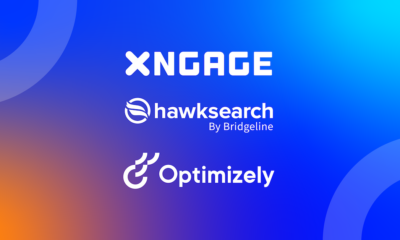
 MARKETING2 days ago
MARKETING2 days agoXngage and HawkSearch join forces with a powerful connector








